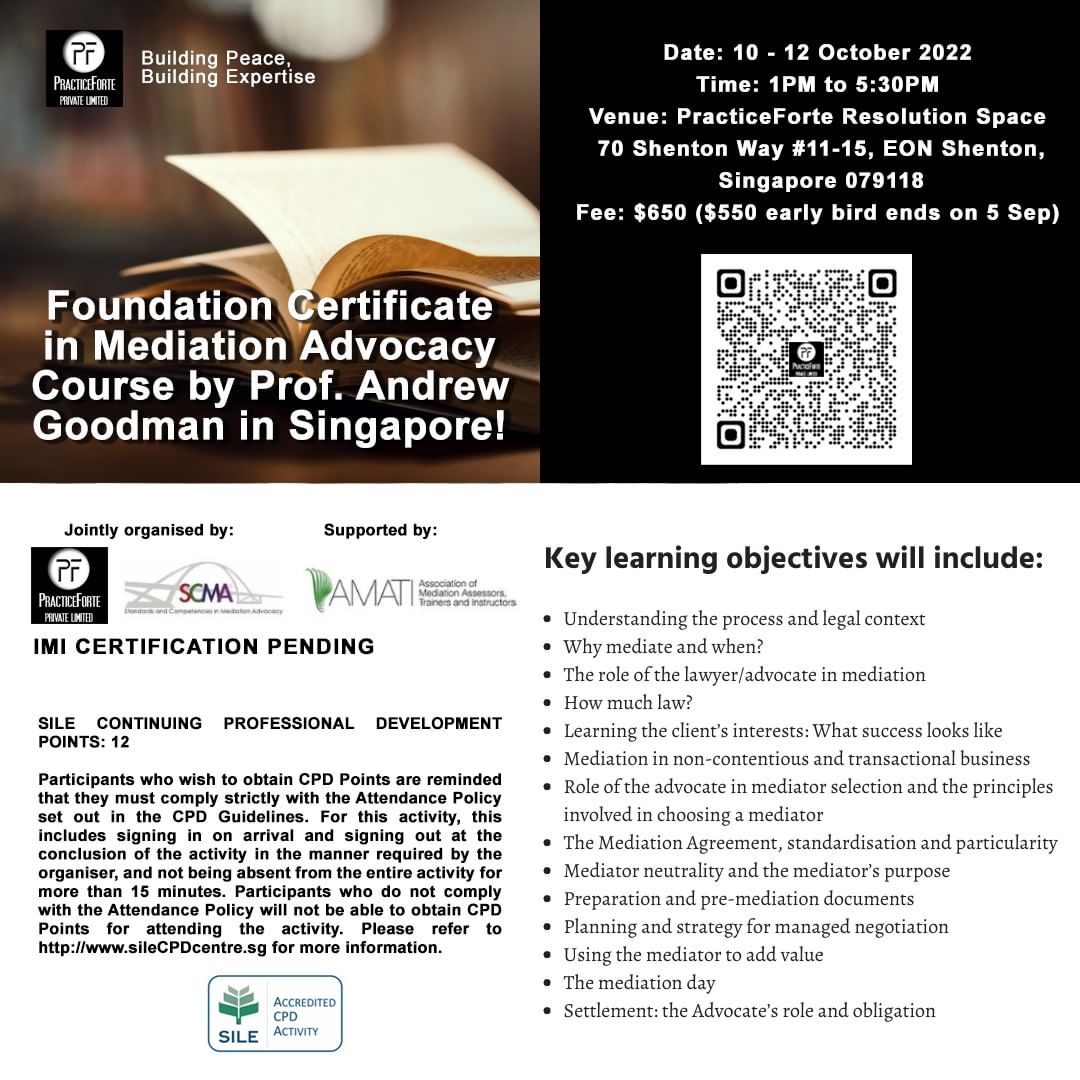
Author: Lim Seng Siew
-

Reflections of An Ex- Intern – By Matthew Chu
1) Learning in a good working environment
Before starting my internship at OTP Law Corporation (OTP Law), I was terribly nervous. Would I have a good relationship with the folks there? How do I leave a good impression? Would I perform well at the firm despite average grades? With these questions weighing heavily on my mind, I started my first day with great trepidation.
My fears were quickly allayed. During my first meeting with the directors, there was no mention of my GPA at all. Instead, they were more interested in finding out about me as a person – what my personal interests were and my time in law school, for instance. I was assured, albeit in jest that there is no need to memorize the entire rules of court to fulfill my responsibilities as an intern.
Additionally, they stressed that so long as I have a good attitude and a willingness to learn, that was all that they wished from me.
Amongst my “missions” seemed also to be “By the end of this internship, your goal is to gain 3kg!”. True to that, the whole of my internship was laden with food.
It was through these interactions that I was able to experience how the firm prioritized their colleagues’ welfare. This is a testament to OTP Law’s stellar work culture, which embodies empathy and treating one another like family.
OTP Law’s environment is also very nurturing. The directors were always encouraging me to ask questions and were always challenging me with questions of their own. I remember having intense in-depth discussions with them about a particular issue concerning a freezing injunction, and who exactly was the proper plaintiff to proceed with the injunction application. Despite my struggles to communicate my points, they were very patient with me. They told me that it was good to slow down, think through so to better frame my arguments. Under their tutelage and close mentorship, I found myself increasingly critical and organized in the way I deal with legal issues.
2) Learning about the law and practiceIn addition to its impeccable work culture, OTP Law also has expertise in a wide range of practice areas. While the firm may be better known for its family law matters and civil disputes or even tech practice, a surprising field that piqued my interest was real estate/conveyancing. The firm has a very experienced conveyancing paralegal, who was very patient. She guided me through the various conveyancing procedures and explained how the conveyancing industry worked. While conveyancing may seem boring to most, the certainty and practicality behind the procedures made conveyancing something that I might consider doing in the future. Hence, OTP Law having a broad scope of practice areas enriched my internship experiences.
3) Learning about running a businessBeyond learning about the law, interning at OTP Law also taught me about running a law practice: dealing with clients; promoting the practice; and adapting the practice to the digital age.
I learnt that a good law firm is highly client centric. I learnt also that most clients call upon lawyers when face with distresses and uncertainties. it is therefore important for lawyers to be patient and empathetic so to better assuage the concerns of clients.
During my internship, I was lucky enough to experience the re-designing of the firm’s website. Something I really enjoyed. That experience taught me how much resources are needed to promote and develop a law practice. Given that I hope to set up my own firm in the future, this experience was particularly insightful.
Another big lesson for me was how what used to be a traditional law firm which was completely reliant on paper adapt to the digital age. At OTP Law, paperless was the way to go and the lack of physical files, the norm. If most firms go this way, the number of trees saved in the process would be immense. Virtual meetings and WFH also meant tremendous saving of time and resources on travelling as well. Looking at how OTP Law adapts shows the importance of flexibility and quick adjustments to the current times and the need to take the initiative to be ahead of the curve. In a way, that made me excited at the possible changes the next generation can bring.
4) Learning about what it means to be a lawyerInterning at OTP Law made me consider a very fundamental question – what does it mean to be a lawyer?
I had three takeaways: First, a lawyer has duties to the court and to the client. Second, a lawyer must not simply do what a client wants us to do. He must always look ahead and properly advise the client on all the consequences including potential legal pitfalls of that course of action. Lastly, lawyering is not just a job, but it is a calling that requires constant reflection and self-development.
A lawyer has a duty both to the courts and their clients. The directors at OTP Law always emphasized that as lawyers are officers of the court, they uphold a sacred duty to ensure that justice is meted out fairly. Thus, lawyers must maintain a high standard of integrity and professionalism, including not misleading the court or inciting clients to provide inaccurate evidence. Weighing on the other side, lawyers must also act in their clients’ best interests. A case dealing with the mental capacity of a deponent to an affidavit made me realise these.Professionalism, I was told, is also in the way we conduct ourselves and how we treat lawyers in opposing camps. Courtesy is another must. One case demonstrated why even though litigation can be an incredibly competitive environment, it is no reason to disrespect your opposing counsel, all the more so when you are in front of the judge.
Next, we are not mere mouthpieces of clients. A lawyer must not simply do what the client asks of him. Lawyers owe a duty to their client to point out the potential legal pitfalls and consequences that might befall them.
Lastly, a lawyer is about constant reflection, self-development and learning. The law is always changing, and lawyers must constantly keep themselves abreast so to better advise their clients. There is no doubt that this is arduous, but it is necessary. It will be a lifetime of never resting on our laurels, but a constant strive to learn and improve. A lawyer must also have a strong centre, to do what’s right and not be tempted to waver to the wrong.
5) Learning to not confine myself to the lawThis I learnt by example from Mylene, the co-director at OTP Law and the co-founder of PracticeForte Pte Ltd (PracticeForte). Just because I am studying the law does not mean that I am confined to just becoming a lawyer. Mylene had a vision of banding small professional firms and in pursuit of that vision, started PracticeForte and PracticeForte Advisory. Today, the Advisory comprised of other law firms, forensic accountants and investigators, counsellors and mediation professionals. A law degree does not have to define what I do. It is what I do with it.
Also, just because OTP Law handles a lot of civil and family disputes does not mean they believe all problems have to be resolved with litigation. They are big believers and firm advocates for trying settlements through mediations, negotiations and other ADR methods.
6) What could I have improved on?In terms of things that I could have done better, I believe I could have taken more initiative on updates, more diligence to meeting datelines and more prompt in asking for help. I have the habit of keeping quiet when I get stuck, but I vow now to ask for help when it happens again. Also, a gentle reminder to myself not to let perfect get in the way of good. It is better that we get something out so that we can at least discuss and then refine and then get better.
7) RecommendationsIt has been a blast working at OTP Law, and I will definitely recommend the firm to my friends seeking internships. The work environment, learning opportunities and people are wonderful, and any interns learning here is sure to experience tremendous growth.
8) ShoutoutsI’m really grateful for my time in OTP Law, and I’d like to thank everyone working there for teaching me!
* Isabel – For being a fighter and juggling all her responsibilities and never complaining – and yet still willing to pull me into OTP Law and mentor me
* Shukrina – For showing me the importance in fighting for a cause, even when things look bleak
* Sandra – For patiently teaching me conveyancing, and looking over my everyday needs
* Susan – For teaching me how to balance being tough and showing compassion. Additionally, thank you for showing me that law is not just a job but a calling
* Mylene – For inspiring me to chase my passions and not being afraid to break free from the mold
* Mr Lim Seng Siew – For teaching me to give the clients not just what they want, but what they need; and to putting the client’s interest above our own
* Chloe – For showing me how to be more efficient in my work and how to properly engage with clients
At the time of writing, Matthew Chu is a law 4 student at the Singapore Management University. He interned with OTP Law Corporation in mid 2022. -

The House You and Your Spouse Are Living In May Not Be Your Matrimonial Home
By Chloe Chua of OTP Law Corporation
To most couples, their matrimonial home is simply the place where they reside together. The legal concept is straightforward: a matrimonial home is one where a couple has purchased a property in which they subsequently stay in for an extended period of time during the marriage.
However, it gets complicated when the property in question is co-owned by others outside of the marriage e.g. one of the spouse’s family members.
This issue of whether co-owned family property can be considered a matrimonial home liable to the division of assets was decided in the ground-breaking case of VOD v VOC and another appeal [2022] SGHC(A) 6. (This is also the case of the S$1 million red packet that has recently taken the local news scene by storm.) The facts relating to the Property are as follows:
a. The Husband’s father had financed the Property solely and had registered the Husband, his mother and brother as joint tenants. It was undisputed that the Husband had a one-third share in the Property. The Husband’s family has resided in the Property since it was purchased, prior to parties’ marriage.
b. The Wife moved into the Property after the marriage. In preparation for the arrival of parties’ son, two bedrooms in the Property were renovated for the parties. The renovations were paid for by the Husband’s father.
c. The Wife moved out with the son after residing in the Property for 33 months i.e. almost 3 years.
The Wife sought to include the Husband’s one-third interest in the Property as part of their matrimonial assets in their divorce proceedings. Her basis was that the parties had lived together in the Property, and it had functioned as their matrimonial home. She also alleged that much effort and moneys were expended to renovate the two bedrooms for their exclusive occupation.
Conversely, the Husband’s stance was that the Property was his parents’ matrimonial home and therefore not that of the parties. According to him, parties only stayed there while they continued to search for their matrimonial home.
The Court held that the Property was not the matrimonial home of the Parties, for the following reasons:
a. The Husband’s one-third interest was a pre-marital gift from his parents which falls outside the definition of “matrimonial asset” as stipulated in Section 112(10) of the Women’s Charter (1). The Wife did not allege that either party had made substantial improvement to the Property during their marriage. Her claim was that parties had resided there for 33 months as their matrimonial home. To this, the Court’s finding at [42] was that “A legal interest coupled with residence will not necessarily mean that the property in question constitutes a matrimonial home” and that “mere residence alone is generally not enough.”
b. The Court found that parties were living in an extended household where the Husband’s father and mother were the true “master” and “mistress”. The parties did not have dominion or make financial decisions regarding the property or the running of the household. As such, the Property was found to be the father and mother’s matrimonial home. The Court has introduced an unprecedented consideration at [39] that “Whether or not other people have lived in the property and how it was used such that it served as their home instead of a matrimonial home for the parties is a relevant circumstance.”
This sudden added requirement of “control” or “dominion” does not sit well with most laypersons’ (and even most legal practitioners’) understanding of a matrimonial home.
From the facts, this was not a case where the parties had little to no say over the Property. The Wife was involved in corresponding with contractors regarding the renovation of their bedroom and the son’s nursery in the Property. It was acknowledged that these 2 rooms were for the couple and their son’s sole occupation. The Husband was also unable to prove that their living arrangement was temporary. Yet, their involvement was deemed as “limited”, which discounts their control over the Property.
This notion implied that a property can only be the home of one couple or even one person who exercises dominion over the household is rather unsettling. It discounts situations where there are multiple couples and single persons staying in a large property, where they might have control over their rooms in the house. From a policy perspective, this might discourage multi-generational or shared living arrangements.
The case of VOD v VOC challenges the understanding that legal interest coupled with residence in a property makes it a couple’s matrimonial home. They must now also have a strong element of control/ dominion over the property. Therefore, be cautioned that the house you and your spouse are living in may not necessarily be your matrimonial home.
At the time of writing, Chloe Chua practices with OTP Law Corporation as a lawyer focusing on family law.
——————–
(1) In this section, “matrimonial asset” means —
(a) any asset acquired before the marriage by one party or both parties to the marriage —
(i) ordinarily used or enjoyed by both parties or one or more of their children while the parties are residing together for shelter or transportation or for household, education, recreational, social or aesthetic purposes; or
(ii) which has been substantially improved during the marriage by the other party or by both parties to the marriage; and
(b) any other asset of any nature acquired during the marriage by one party or both parties to the marriage,
but does not include any asset (not being a matrimonial home) that has been acquired by one party at any time by gift or inheritance and that has not been substantially improved during the marriage by the other party or by both parties to the marriage. -

Conditional Fee Agreements (CFAs) With Your Lawyer
by Lim Seng Siew, Director OTP Law Corporation
The Basics
Singapore recently passed laws to allow for lawyers to enter into conditional fee agreements with their clients for certain types of cases. The purpose of such changes is to allow for better access to justice for deserving cases. The changes allow a flexible fee arrangement, in addition to the usual arrangements, between the client and the lawyer. As Second Minister of Law Mr. Edwin Tong SC said, CFAs are “not intended to replace traditional fee structures.”
First off, conditional fee agreements or CFAs are not allowed for all types of litigation or disputes cases. Only arbitration cases, whether domestic (Singapore dispute involving Singapore based parties) or international, and certain cases before the Singapore International Commercial Courts can CFAs apply. Matrimonial disputes and disputes that are decided by the domestic Singapore courts are excluded.
Second, conditional fees are not contingency fees. The key difference is that conditional fees is not fees based on the amount of damages or sums awarded. That is, it cannot be a percentage of the damages awarded to the winning party. Instead in a conditional fee agreement, there will be a base legal fee. If a client wins the case, the lawyer can charge an uplift fee that can be ‘x’ times that base legal fee. There can also be other creative fee solutions crafted between the lawyer and the client, just that it cannot be tied to the damages awarded.
Now that the basics are out of the way, let us deep dive into the world of CFAs.
The Law
In January 2022, Singapore passed a bill amending the Singapore Legal Profession Act by adding a new Part 8A to allow for CFAs. The amendments took effect on 4 May 2022 along with the related regulation, The Legal Profession (Conditional Fee Agreement) Regulation 2022 (“Regulation”).
Before the amendment, a lawyer in Singapore cannot enter into such arrangements with clients as they are considered a breach of the legal doctrine prohibiting champerty and maintenance. The aim of the doctrine is to preclude frivolous litigation. As one of the judges in a 1993 English case (Giles v Thompson) said: “In modern idiom, maintenance is the support of litigation by a stranger without just cause. Champerty is an aggravated form of maintenance. The distinguishing feature of champerty is the support of litigation by a stranger in return for a share of the proceeds.”
The Allowed Cases
CFAs are now allowed for: (a) international and domestic arbitration cases in and outside Singapore; (b) cases started in the Singapore International Commercial Courts (SICC) and remain in the SICC throughout the case; and (c) court and mediation proceedings related to the aforesaid.
CFAs can cover preliminary work done for such cases. As examples, the initial advice and pre-commencement negotiations to settle the dispute can be covered under a CFA. CFAs continue to apply even if the intended case is not started or is settled in the interim.
Personal injury cases started in a Singapore court cannot be the subject of a CFA nor can criminal or matrimonial cases.
The CFA
The Part 8A of the Legal Profession Act requires that the conditional fee agreement be in writing and signed by the client. The CFA cannot have any clause that excludes the lawyer’s liability for negligence and the existing rules preventing a lawyer from overcharging continue to apply. It also cannot have any clause for fees to be payable as a percentage of the damages or other amounts awarded.
As the CFA is an arrangement between the lawyer and the client, it does not affect the costs obligation of any losing party in an arbitration or SICC case, that is the losing party will still be ordered to only pay reasonable costs to the winning party. The winning party cannot ask the losing party to pay more than that, in particular the losing party cannot be asked to pay any part of the uplift fee in excess of reasonable costs.
If a conditional fee agreement does not satisfy the requirements under Part 8A, it does not mean that the client need not pay to the lawyer any fees. The client will still have to pay the lawyer what is accessed as reasonable fees payable by clients to their own lawyers as if there is no CFA.
Under the Regulation, a lawyer must provide certain key information about the CFA to the client. They are information about: (a) the nature and operation of the CFA; (b) the client’s right to seek independent legal advice about the CFA; (c) the uplift fee not being recoverable from any losing party; and (d) the client still being liable to the other party for costs ordered against the client by the arbitral tribunal or the SICC.
The CFA must also set out:
(a) The circumstances or conditions under which the client has to pay to the lawyer his fees. This will include arrangements about the base legal fees, the disbursements and the uplift fee.
(b) How the uplift fee is calculated and an estimate of the range of the uplift fee. There is no prescribed limit to any uplift fee other than the usual ones concerning overcharging.
(c) A mandatory cooling off period of 5 days during which either party may terminate the CFA by written notice.
(d) That any changes to the CFA must be in writing and signed by all parties. The changes to the CFA that relate to costs must have a 3 days cooling off period.
(e) That, if the CFA (or its changes) are terminated by the client during the cooling off period, the client will only be liable for costs for work done by the lawyer during the cooling period that was expressly instructed or agreed to by the client.
The Benefits
CFAs are not suitable for all cases. Clients with a meritorious SICC or arbitration case but face temporary liquidity or cash flow issues (as an example, because of the pandemic) can work with their lawyers to craft a CFA that is a ‘win-win’ solution for all parties concerned. CFAs are also a tool for sophisticated commercial clients to work out alternatives with their lawyers to manage legal cost risks.
CFAs do not just benefit potential claimants of a case. With some creativity, CFAs can also be used for potential defendants of the right case to manage legal cost risks.
Although CFAs are new in Singapore, they are already used in many civil law countries and are expanding in several common law countries. We share the knowledge and experience of our PracticeForte Affiliates in such countries. Our clients can benefit from our shared knowledge and experience in this space. If you want to find out more, do contact us at enquiries@otp.sg.Lim Seng Siew is the co-director and Head of Civil Disputes and Technology Practice at OTP Law Corporation. For his full CV, please click here.
-

The Biased Mediator
The Biased Mediator
By PracticeForte Advisory Affiliate Christian von Baumbach
(this article was first published in E-Mediation Magazine)Mediators are 100% impartial!
They are not passive observers of a conflict, of course, but actively support all parties equally to express their views and needs and come to solutions that are in their best interest. Most definitions of mediation emphasize the role of the mediator as a neutral or impartial third party. Impartiality is a key principle of mediation.
But is this really true? Probably not, at least not 100%. Biases are a natural, and to some extent unavoidable, part of human nature. Our biases help us to navigate through our daily lives without having to think too much about every action and encounter.
What about our professional lives? Can we leave our biases at the door when we enter the mediation room? Maybe to some extent, but probably not completely. To be honest, even in my professional role as a mediator I am influenced by my biases. My biases keep me from being truly impartial. In most mediations I feel closer to one party than the other or feel that the arguments of one party are more reasonable than the other.
This can be a problem if this influences me in a way where I favour one party more than the other. As the mediator I am responsible for leading the process, and the process naturally has an impact on the outcome. I could, for example, lead the conversation in a way that helps party A at the expense of Party B. I could repeat or visualize some arguments in greater detail while neglecting others. Or the parties simply feel the greater sympathy towards one side. All of this could probably happen unconsciously and therefore would be difficult to avoid.
So, it is very important to be aware of our biases, train our perception and develop skills to stay as impartial as possible. How can we achieve this?
Seeing through cultural lenses
Our perceptions and values are strongly influenced by our surroundings and our peer groups, especially at a young age. Our family members, friends, classmates and others have an impact on how we perceive the world around us and how we judge others. This cultural background shapes our perception and influences our judgement. Most of the time we are not even aware of the cultural lenses that we look through. We believe that our view on the world is real, and therefore opposing, unexpected behaviour must be somehow wrong or mischievous.
But we can train to view the world through different lenses, to look at the world from different angles. This is, of course, what mediators always pursue, but not all mediators take cultural biases into account. To do so, we need to achieve knowledge about cultural dynamics and reflect on our own cultural background, as well as on other cultural aspects. We also need to develop an attitude of respect and interest towards people from other cultural backgrounds. Culture is complex and there is always something new to learn. It also helps to talk to a lot to people from very different social and cultural backgrounds to understand how they perceive the world. Through these theoretical and practical experiences, we gain intercultural competence[1] that helps us to understand and deal with our biases.
One important aspect here is that culture is by no means limited to national culture. Modern cultural theories like the concepts of open culture and multicollectivity by Professor Bolten[2] apply non-binary concepts to culture. Professor Bolten points out that all humans belong not only to one culture, but instead to multiple collectives. Each collective has an influence on us and therefore on our own biases. These concepts may help us to understand our own diverse cultural background as well as that of others. It supports a view that is less black and white and more colourful.
Co-Mediation
Aware of cultural biases, in cross-border family mediation we often work in co-mediation with a team of mediators from different backgrounds that match the background of the parents. The German NGO MiKK[1] has developed the 4B mediation model, in which co-mediator teams with the following characteristics are assigned to each case: 1. Bi-lingual: Parents may speak in their mother tongue as well as in the language of the relationship during the mediation. 2. Bi-cultural: The co-mediator team will reflect the culture of the parents. 3. Bi-professional: One mediator will be of a legal background and the other will be of a psychosocial (psychological or pedagogical) background. 4. Bi-gender: The co-mediator team will reflect the gender of the parents.
Each mediator will have biases and not every mediator can support its respective party equally, but together as a team they can help each other to understand and overcome their biases and support the parties equally. That is why each co-mediation is a wonderful learning experience for the mediators as well.
This mediation model is also effective to counter possible biases that the parties might have against the mediators. Someone from Germany might feel better with a German mediator in the room while someone from India might prefer a mediator from India, even if both mediators are effectively impartial to both parties.
[1] MiKK e.V. International Mediation Centre for Family Conflict and Child Abduction (https://www.mikk-ev.de/en/)
Prejudice vs. generalization
Not all assumptions are wrong. A helpful difference can be made between prejudices and generalizations. Prejudices are preconceived opinions that are not based on reason or actual experience. This is a negative and destructive form of bias. Generalizations on the other hand are realistic assumptions that are based on researched facts or personal experience. Generalizations can help us to understand a situation or people.
Reflecting on our own beliefs, and understanding which are based on facts and experiences and which are a result of prejudices, can be very important.
Body and mind
As biases are largely part of our subconscious. It can be difficult to approach them on a logical, conscious level. However, they will manifest physically through our bodies, gestures and movements. Therefore, mediators should pay attention to their body reactions, their posture, breath and gestures. All these hint at real thoughts, including biases. For example, sometimes I notice that I subconsciously have a greater physical distance to one party or that I physically face more towards one side. This might hint at a subconscious bias. There are two ways to approach this: One is to reflect on this, maybe through supervision. The other is to deliberately correct my position in the room or my body posture. There is a close connection between body and mind and one effects the other. It can help to develop a better understanding for the connection between body and mind, for example through meditation, yoga practice or martial arts. Personally, I have learned a lot from my Aikido practice over the years[1].
[1] Article on Aikido and Mediation: https://baumbachmediation.com/en/aikido-and-mediation/
Conclusion
Every mediator is influenced by his or her biases, often on a subconscious level, and this might impair our impartiality. To avoid that, we need to be aware of our biases, train our perception, and develop skills to stay as impartial as possible. Intercultural competence helps us to understand our own biases and treat others with respect. Co-mediation is a wonderful concept where two mediators with diverse backgrounds work together to overcome their own biases and acknowledge possible biases by the parties. Biases in the form of generalization might be helpful if we stay cautious of prejudices. Lastly, our body is a great indicator for our subconsciousness and helps us to understand and influence our own biases.


-

Pros & Cons of Online Mediation (Part 2)
By PracticeForte advisory affiliates Christian von Baumbach in collaboration
with Susan TayPros of Online Mediation
If you are reading this article, then you are likely already a believer of mediation. Perhaps you have heard enough good things about mediation to want to understand more?
Nonetheless, it is still worthwhile to laud mediation. It is after all, THE modern, flexible, and effective process for solving disputes and making joint decisions in important matters. Through mediation, family members, colleagues, business partners – basically everybody who has an interest in respectful cooperative relationships – can potentially have meaningful discussions, gain a better understanding of each other’s perspectives and regain mutual trust. The goal of each mediation should always be to find enduring solutions that are in the best interest of everybody involved.
Generally, people meet physically in one room for a mediation. But what to do if large distances lie between them? Not always is it possible to travel for a meeting to another city or even country. In such cases online mediation might be a suitable option.
PracticeForte Advisory and its affiliates provide professional online mediations, and in the next 2 articles, we would like to highlight some of its challenges (Part 1 here) but also its advantages.
Advantages
Easy Scheduling: In our own experiences, the time taken for a mediation in person to happen usually takes weeks if not months. The logistical needs include: coordinating at least 3 parties’ time table to physically travel to the venue; the availability and booking of the venue, staffing needs for requirements on food and printing or other amenities.
Videoconferencing is a matter of coordinating everyone’s schedule and it is easier because no travelling time need to be considered. We also don’t need onsite staff. All everyone really needs is a private space in your own home for the mediation to happen.
Costs: In an expensive city like Singapore, it can run to an additional sum of at least S$1000.00 just for the booking of the venue for mediation. That rate is for the availability of at least 3 rooms, a mediation room and 2 breakout rooms from 9am-6pm. Overtime rates will apply.
Then there is the travelling costs of all parties. Mediators will charge the parties their travelling and lodging costs if the mediation is to be conducted in another state or in another country.
Online mediation however can mean reducing these costs to mere tens of dollars. That is the subscription fee for a reliable videoconferencing platform.
Effective Videoconferencing Tools: With the massive uptake of videoconferencing facilities, providers are now equipped to improve the tools and we see many of these tools being added which greatly assist mediations.
These tools include breakout rooms where private caucuses can be conducted safely. The ability to share a whiteboard where agendas can be written for visualization and better clarity and understanding by parties. In addition to the ability to quickly share documents as most of us store our documents in our computers. These tools also facilitate quick drafting of settlement agreements.
Ways of Minimizing Cons: As more of us engage in videoconferencing, we find ways to minimize the discomfort of staring into screen for too long. 1st, mediation online can be restricted to 2 hour per session. We will need a longer timeline, yes, but longer time can mean advantages. Parties have the time and space to think through what they want and whether the proposals can work. This will be less post settlement dissonance.
For security and confidentiality, there are ways to ensure 1stly that no one else is in the room. A 360 video run of the room has been employed by the courts in Singapore for instance to ensure that a witness standing for trial is by himself/herself. Why not for online mediation?
Conclusion
Many mediators may always prefer to meet in person because no matter how sophisticated or how easy it is for us to use videoconferencing, the rapport, empathy and natural setting of an in person meeting simply cannot be matched.
Yet, in cases where a physical meeting is difficult or even impossible, a meeting in a virtual environment provides a better than decent opportunity.
Perhaps it does not have to be an either-or question. Online mediation can be a good starting point to see if a mediation makes sense before the parties meet in a physical location. Vice versa, parties can first meet in presence and continue online at a later point.
What are your views on online mediation? We will love to have you share your experiences and ideas with us.







